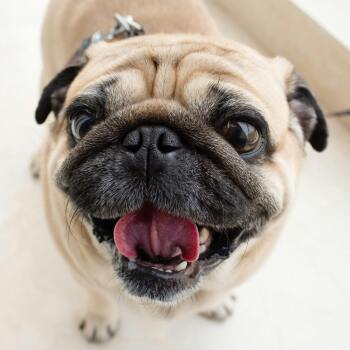Pugs

Pugs: Compact, Comical, and Completely Charming
With their wrinkly faces, wiggly butts, and lovable personalities, Pugs are proof that great things come in small, snorty packages. These little comedians have a big heart and an even bigger sense of humor—there’s a reason they’re one of the world’s most beloved breeds.
Why Pug Lovers Can't Get Enough
Pugs are the ultimate blend of goofy and loyal. Their short bursts of energy and affection make them great family companions without requiring hours of exercise each day. Whether you live in an apartment or a house with a yard, Pugs adapt well as long as they’re close to their people.
They love children, get along with other pets, and are generally content to curl up on the couch after a few zoomies. They may not be expert guard dogs, but they’ll always let you know if someone’s at the door.
A Few Quirks to Keep in Mind
Of course, life with a Pug isn’t all snuggles and smiles. They can be stubborn during training, and housebreaking may take a little longer than expected. Thanks to their flat faces, they’re also more prone to snoring and overheating—so the A/C will become their best friend in warmer months.
They’re prone to separation anxiety if left alone too long, and those iconic face wrinkles? They require regular cleaning to prevent skin irritation.
A Royal Past for a Regal Pup
Pugs trace their roots back to ancient China, where they were bred to warm the laps (and hearts) of royalty. These dogs were so revered that emperors appointed guards just for them. Eventually, Pugs made their way to Europe, stealing the spotlight in royal courts across the continent.
They’ve remained popular ever since, known for their loving nature, silly antics, and unmistakable looks. With good care, Pugs typically enjoy a lifespan of 13–15 years.
Health Concerns in Pugs
- Liver Health: Portosystemic Shunt (PSS)— Some Pugs are born with a liver blood flow issue that prevents the organ from properly filtering toxins. Signs include poor growth, confusion, or seizures. A liver function test before anesthesia can help detect it early—and treatment ranges from dietary changes to surgery.
- Chylothorax— This rare but serious condition causes a buildup of fluid in the chest. If your Pug shows signs of labored breathing or lethargy, emergency care is essential.
- Eye Injuries & Conditions— Their adorable bulging eyes make them vulnerable to:
- Corneal injuries from scratches or foreign objects
- Entropion, where eyelids roll inward
- Dry eye, a painful condition if untreated
Avoid letting your Pug hang their head out of car windows, and report any redness, discharge, or squinting right away.
- Diabetes— Pugs are at higher risk for diabetes. Watch for increased thirst, urination, and weight loss. With early diagnosis, daily insulin and diet changes can keep things well managed.
- Atopy (Skin Allergies)— Instead of sneezing, dogs with allergies get itchy. If your Pug is licking their paws, scratching, or getting frequent ear infections, they may have environmental allergies. Many treatment options are available to keep them comfortable.
- Mange (Demodex mites)— Pugs may struggle with mite overgrowth, especially when young. Signs include patchy hair loss and irritated skin. Most cases are manageable with vet care and skin support.
- Lip-Fold Pyoderma— Those cute face wrinkles can trap bacteria and moisture, causing infection. Look for redness, odor, or excessive licking around the mouth. Cleaning folds and, in some cases, antibiotics or surgery can help.
- GME (Granulomatous Meningoencephalitis)— This rare inflammatory disease affects the brain and is more common in small breeds. Sudden behavior changes, vision loss, or balance issues warrant immediate vet attention.
- Joint & Bone Concerns— Pugs can be affected by:
-
Hip/elbow dysplasia
-
Legg-Calvé-Perthes Disease, a hip joint disorder in young dogs
-
Hemivertebrae, a spinal malformation that can cause nerve issues
Keeping your Pug lean and monitoring any changes in movement is key.
-
- IVDD (Intervertebral Disc Disease)— Disc issues in the spine can cause pain or paralysis. If your Pug suddenly refuses stairs, yelps, or drags their legs, get to a vet ASAP.
- Mast Cell Tumors— Pugs are more prone to this type of skin cancer. Any lump or bump should be checked early—most are treatable when caught in time.
- Degenerative Myelopathy— This progressive condition weakens the hind legs over time. While not curable, physical therapy and support tools can improve comfort and quality of life.
- Bladder & Kidney Stones— Pugs are at risk for developing stones, especially if they have high uric acid levels. Blood in the urine or straining to pee is always a reason to call the vet.
- Respiratory Distress Syndrome— Because of their brachycephalic (short-nosed) structure, Pugs can struggle with breathing—especially in heat or under stress. Heavy panting, blue gums, or collapse are signs of a serious emergency. Some dogs may benefit from airway surgery for long-term relief.
Keeping Your Pug Happy, Healthy, and Snuggly
From playful antics to snuggles on the couch, your Pug is sure to bring years of joy. Regular vet visits, a balanced diet, and a little extra care for those signature features go a long way.
Ready to Learn More? We’re Here to Help!


